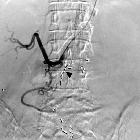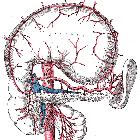Pseudoaneurysma der Milzarterie


Splenic artery pseudoaneurysms are a rare type of pseudoaneurysm arising from any portion of the splenic artery and its branches.
Clinical presentation
Unlike splenic artery true aneurysms, splenic artery pseudoaneurysms will nearly always present with symptoms . While there occurrence may be higher, fewer than 200 cases of splenic artery pseudoaneurysms are reported in the English literature .
Pathology
While they are sometimes grouped under splenic arterial aneurysms, they are distinct entity and are different from true aneurysms of the splenic artery. In contrast to a true aneurysm the pseudoaneurysm wall contains only the intimal and medial layers .
Their size can vary and if larger than 5 cm they are called giant splenic artery pseudoaneurysms .
Etiology
They usually occur as a complication of :
- pancreatitis
- trauma
- iatrogenic and postoperative causes
- peptic ulcer disease (rarely)
In the case of pancreatitis, pancreatic enzymes are thought to cause a necrotizing arteritis with destruction of vessel wall architecture and fragmentation of elastic tissues.
In the traumatic setting, they are actually more often intraparenchymal and rarely involve the main splenic artery.
Radiographic features
CT
CT is the modality of choice in assessing splenic trauma:
- true aneurysms will appear just as they do at other locations
- intraparenchymal pseudoaneurysms have a similar appearance to active hemorrhage on initial scanning but do not increase in size on delayed phases and follow the blood pool on all phases
- intraparenchymal pseudoaneurysms and AV fistulas have a similar appearance and cannot be differentiated on CT
- in contrast, active hemorrhage appears as a high density (80-95 Hounsfield units) material due to the extravasation of IV contrast media that increases in size on delayed imaging
See also
Siehe auch:
und weiter:

 Assoziationen und Differentialdiagnosen zu Pseudoaneurysma der Milzarterie:
Assoziationen und Differentialdiagnosen zu Pseudoaneurysma der Milzarterie:




